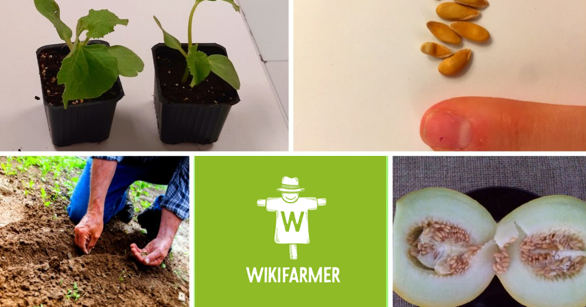Growing Melons Backyard – All you need to know

This post is also available in:
This post is also available in:
![]() Español (Spanish)
Español (Spanish) ![]() Français (French)
Français (French) ![]() Deutsch (German)
Deutsch (German) ![]() Nederlands (Dutch)
Nederlands (Dutch) ![]() हिन्दी (Hindi)
हिन्दी (Hindi) ![]() العربية (Arabic)
العربية (Arabic) ![]() Türkçe (Turkish)
Türkçe (Turkish) ![]() 简体中文 (Chinese (Simplified))
简体中文 (Chinese (Simplified)) ![]() Русский (Russian)
Русский (Russian) ![]() Italiano (Italian)
Italiano (Italian) ![]() Ελληνικά (Greek)
Ελληνικά (Greek) ![]() Português (Portuguese (Brazil))
Português (Portuguese (Brazil)) ![]() Indonesia (Indonesian)
Indonesia (Indonesian)
More and more people like to grow their own fruits and vegetables for hobby, self-satisfaction and in order to control what they eat. However growing fruits and vegetables in your backyard has some risks, do’s and there are some things you certainly need to avoid.
Things to consider when growing melons in your garden:
- The 4 important elements when growing melons in your backyard are: Full sun, Enough Room, Covered Soil (so that we will increase its temperature quickly and control weeds) and Good Drainage.
- If you consider starting growing melons from seeds, you may have in mind that in most cases, the seeds you have collected after eating melons at home, may be sterile and thus not be able to produce fruits. Instead, consider buying certified seeds from a legitimate seller. This will ensure high germination rates and you will not lose your time.
- If you consider starting growing melons from plants, you may buy your seedlings from a legitimate seller and then transplanting them into their final positions. You have to choose the type of melon you are going to plant carefully. You may ask your local nursery for soil-borne diseases that are commonly found in your region. In this way, you will be able to choose a hybrid seedling that has strong chances to overcome difficulties and finally produce tasty melons.
- Melons come from Africa. They need warm soil to develop and thrive. As a rule of thumb, we will plant directly our seeds or transplant our young melon seedlings only after we have planted every other vegetable in our garden during late spring. Melons need temperatures from 18°C to 35 °C (64 °F – 95 °F) and plenty of sunlight. Even a mild frost may cause serious damage to tissues and fruits. In tropical climates, winter is the best period to start melon seedlings, while in places with a cooler climate, we can plant our melon seedlings during late spring. Commercial melon growers cover the soil with a black plastic film, in order to heat the soil, boost plant’s growth and control weeds. Backyard growers can do something similar, by covering the soil around the melon plant with a black plastic film or cover.
- Before drilling or planting, we may need to apply some organic fertilizers to increase nutrient levels of the soil. Many growers prefer to apply manure or composts as fertilization methods during the growing period, mainly to increase nitrogen and potassium soil levels.
- We must choose a sunny spot in our field with good drainage. When growing melons, spacing is very important. If we overcrowd the plants, they will not be able to produce well-formed pepos. As a rule of thumb, we will plant 1 melon plant per 1 square meter. If all things go well, we will be able to collect two well-shaped melons from this plant. However, if we grow vertically our plants in trellis (bamboo stakes), we can plant two seedlings per 1 square meter. Growing melons in raised beds is an option, as in this way we can irrigate more easily without watering the foliage.
- Melon flesh contains water at a percentage of nearly 91%. Thus, melons need a lot of water in order to produce well-shaped fruits with tasty flesh. You shall keep them moist, but avoid excessive irrigation. Excess humidity may cause problems with germination. In addition, waterlogging during the fruit ripening stages will most probably cause watery, tasteless fruits. We shall better not water the foliage, as this will favor disease outbreak. During the maturing stages, the water needs of the plant normally decrease. If we over irrigate at these stages, we will turn up having watery, tasteless melons.
- Some producers prefer to prune the peripheral stems of the plant. Pruning also facilitates proper aeration and thus, protects the plant from humidity favored infections. Other producers claim that -by pruning- we definitely delay the growth and fruit setting of the plant. However, almost all producers agree on removing most of the malformed or underdeveloped melons, leaving 1-3 per plant. This method is called “thinning”. This method encourages the plant to transfer its nutrients to fewer fruits, which will eventually become bigger in size and tastier.
- Harvesting melon when growing from seed takes on average 100 to 130 days. Most varieties are ready to be harvested 78-90 days after transplanting. If we can pull the stem out of the fruit easily, then our melons are ready to be harvested.
- When growing melons, keep in mind that crop rotation is an easy way to control pests and diseases as well as avoid soil depletion. As a general rule, we shall avoid growing Cucurbitaceae in the same soil for more than two consecutive years.
Technically, the word melon refers to any member of the family of Cucurbitaceae, however, most people with the term melon refer specifically to Cucumis melo.
Check Out Musk Melon Prices per kg and Suppliers









































































